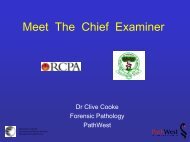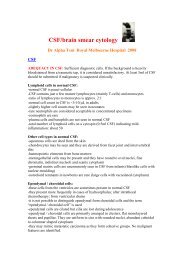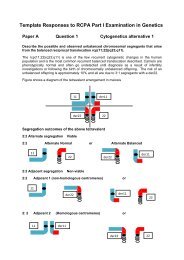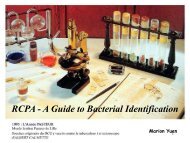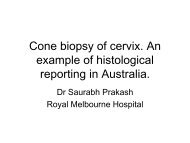Dr Alpha Tsui Royal Melbourne Hospital 2008 - RCPA
Dr Alpha Tsui Royal Melbourne Hospital 2008 - RCPA
Dr Alpha Tsui Royal Melbourne Hospital 2008 - RCPA
You also want an ePaper? Increase the reach of your titles
YUMPU automatically turns print PDFs into web optimized ePapers that Google loves.
Salivary gland cytology<br />
<strong>Dr</strong> <strong>Alpha</strong> <strong>Tsui</strong> <strong>Royal</strong> <strong>Melbourne</strong> <strong>Hospital</strong> <strong>2008</strong><br />
Approach to salivary gland lesions:<br />
1. determine whether the lesion is indeed from the salivary gland. It may be from a<br />
lymph node, skin lesion, soft tissue tumour, thyroid, etc<br />
2. is it non-neoplastic or neoplastic ?<br />
3. 1 cell or 2 cell population (epithelial, myoepithelial cells) ?<br />
4. identify the predominant cell type: Basaloid, squamoid, oncocytic, clear cell,<br />
sebaceous, spindled<br />
5. identify background change and whether stroma-rich or stroma-poor: Lymphoid<br />
background, mucin, hyaline globules / stromal matrix, cystic change<br />
6. if neoplastic, is it benign, low grade or high grade malignancy ? (look at cellularity;<br />
cohesiveness of the cells; degree of nuclear pleomorphism; chromatin pattern; N/C<br />
ratio; nucleoli; cytoplasmic differentiation; stroma to cell ratio; mitoses; necrosis)<br />
7. determine specific diagnostic features (precise subtyping of benign or malignant<br />
lesions is usually not critical as there is little influence on subsequent management)<br />
8. is the lesion primary or metastatic ? (requires clinical history; may need to do<br />
immunostains on the cell block)<br />
Morphological patterns:<br />
Neoplasms with basaloid cells:<br />
-basal cell adenoma / carcinoma<br />
-adenoid cystic carcinoma<br />
-cellular pleomorphic adenoma<br />
-primary lymphoepithelioma-like carcinoma<br />
-metastatic small cell carcinoma, Merkel cell carcinoma<br />
-eccrine tumours, pilomatrixoma, basal cell carcinoma from overlying skin<br />
-metastatic basaloid squamous cell carcinoma<br />
-lymphoma<br />
Neoplasms with squamoid cells:<br />
-low grade mucoepidermoid carcinoma<br />
-salivary duct carcinoma<br />
-metastatic squamous cell carcinoma<br />
-squamous metaplasia in Warthin's tumour and pleomorphic adenoma<br />
Neoplasms with oncocytic cells:<br />
-Warthin's tumour<br />
-oncocytoma<br />
-oncocytic carcinoma<br />
-salivary duct carcinoma<br />
-acinic cell carcinoma<br />
-metastatic Hurthle cell carcinoma from the thyroid<br />
-mucoepidermoid carcinoma (rarely)
Neoplasms with clear cells:<br />
-clear cell oncocytoma<br />
-myoepithelioma<br />
-mucoepidermoid carcinoma<br />
-acinic cell carcinoma<br />
-epithelial-myoepithelial carcinoma<br />
-clear cell adenocarcinoma<br />
-metastatic clear cell carcinoma (e.g. from the kidney)<br />
Neoplasms with sebaceous differentiation:<br />
-sebaceous adenoma / lymphadenoma<br />
-monomorphic adenoma<br />
-pleomorphic adenoma<br />
-Warthin’s tumour<br />
-mucoepidermoid carcinoma<br />
Lesions with spindled cells:<br />
-non-specific fibrosis<br />
-nodular fasciitis<br />
-schwannoma<br />
-myoepithelioma / myoepithelial carcinoma<br />
-primary sarcomatoid carcinoma, sarcoma, carcinosarcoma<br />
-metastatic carcinoma, melanoma<br />
Lesions containing lymphocytes:<br />
-chronic sialadenitis<br />
-benign lymphoepithelial lesion<br />
-lymphoepithelial cyst<br />
-intraparotid lymph node<br />
-Warthin's tumour<br />
-sebaceous lymphadenoma<br />
-acinic cell carcinoma<br />
-mucoepidermoid carcinoma<br />
-primary lymphoepithelioma-like carcinoma<br />
-lymphoma<br />
Lesions with mucin:<br />
-mucocoele (rarely involving the parotid and submandibular glands)<br />
-mucoepidermoid carcinoma<br />
-mucinous adenocarcinoma<br />
-pleomorphic adenoma (rarely)<br />
Neoplasms with hyaline globules or fibrillary stromal matrix:<br />
-pleomorphic adenoma<br />
-basal cell adenoma<br />
-adenoid cystic carcinoma (not seen in solid variant or poorly differentiated tumour)<br />
-epithelial-myoepithelial carcinoma<br />
-polymorphous low grade adenocarcinoma
Neoplasms with cystic change:<br />
-Warthin’s tumour<br />
-pleomorphic adenoma<br />
-cystadenoma<br />
-mucoepidermoid carcinoma<br />
-acinic cell carcinoma<br />
-cystadenocarcinoma<br />
-metastatic e.g. cystic squamous cell carcinoma (commonly from nasopharynx)<br />
Tumours with 2-cell population (epithelial and myoepithelial cells):<br />
-pleomorphic adenoma<br />
-basal cell adenoma / basal cell adenocarcinoma<br />
-adenoid cystic carcinoma<br />
-epithelial-myoepithelial carcinoma<br />
Tumours with 1-cell population (epithelial or myoepithelial cells):<br />
-myoepithelioma<br />
-canalicular adenoma<br />
-acinic cell carcinoma<br />
-oncocytoma, oncocytic carcinoma<br />
-polymorphous low grade adenocarcinoma<br />
-salivary duct carcinoma<br />
-clear cell adenocarcinoma<br />
ADEQUACY: Sufficient diagnostic material. At least 2 passes (one dedicated for cell<br />
block if likely to require immunostains e.g. difficult morphology, metastatic tumour,<br />
lymphoma)<br />
Normal salivary gland components:<br />
-acinar tissue of serous or mucinous type, adipose tissue, ductal epithelium<br />
-serous acinar cells show basophilic granular cytoplasm (Diff-Quik) with PASD<br />
positive cytoplasmic granules; usually in lobulated spherical clusters<br />
-mucinous cells are tall, columnar with abundant, finely granular or vacuolated<br />
cytoplasm and basally located small round nuclei<br />
-ductal cells seen as monolayered, cord-like or 3-D fragments<br />
-ductal cells have scant cytoplasm and round to oval, small and dark nuclei<br />
-myoepithelial cells are rarely seen as an isolated component in normal tissue and<br />
they are closely associated with epithelial structures<br />
-myoepithelial cells have oval to plasmacytoid shape, oval to round nuclei, moderate<br />
amounts of cytoplasm or as bare nuclei<br />
-other variable cell types: oncocytes (increase with age), metaplastic squamous cells,<br />
sebaceous cells, lymphoid cells<br />
Crystalloids:<br />
-crystallised amylase common in cystic lesions of the parotid, appearing as rods,<br />
squares, rectangles, needles, polyhedral shapes; non-birefringent (dark blue on Diff-<br />
Quik, orange on Pap)<br />
-collagenous crystalloids: usually seen in pleomorphic adenoma, appear as radially<br />
arranged, needle shaped crystals (yellow or green with Pap)
-tyrosine-rich crystalloids may be seen in stromal component of pleomorphic<br />
adenoma, adenoid cystic carcinoma, acinic cell carcinoma, low grade polymorphous<br />
adenocarcinoma (flower-petal crystalline structures, often with 'sun-burst' appearance;<br />
yellow-tan with Pap, blue with Diff-Quik; refractile; non-birefringent)<br />
-cholesterol crystals<br />
-calcium oxalate crystals<br />
Specific entities:<br />
Non-neoplastic cysts:<br />
-water-like or viscous mucoid aspirate<br />
-complete collapse of the cyst after aspiration<br />
-histiocytes and other inflammatory cells<br />
-epithelial cells - cuboidal and squamoid<br />
Lymphoepithelial cyst:<br />
-clear or turbid fluid (almost caseous-like material)<br />
-inflammatory cells, macrophages, lymphocytes, immunoblasts, tingible body<br />
macrophages, lympho-histiocytic aggregates, squamous cells, ciliated or mucinous<br />
cells<br />
-recognition of a nonlymphoid, epithelial squamous component is important<br />
-squamous component consists of intermediate to superficial cells and numerous<br />
anucleate squames<br />
-multinucleated giant cells and cholesterol crystals are often present<br />
-lack of oncocytes is a clue (present in Warthin's)<br />
-wide maturational spectrum of lymphocytes seen (predominantly small and mature in<br />
Warthin's)<br />
Acute sialadenitis:<br />
-may be bacterial / viral in aetiology or secondary to duct obstruction by calculi<br />
-numerous neutrophils<br />
-may see bacteria in the background<br />
Chronic sialadenitis:<br />
-scarcely cellular<br />
-ductal epithelium in clusters and sheets<br />
-scanty acinar groups with atrophy<br />
-occasional fibroblasts, lymphocytes, neutrophils and macrophages<br />
-beware squamous metaplastic cells which may show reactive atypia<br />
Necrotising sialometaplasia:<br />
-pools of mucus, inflammatory cells, metaplastic squamous cells showing moderate<br />
reactive atypia<br />
Features favouring necrotising sialometaplasia: necrosis, squamous cells,<br />
typical site: palate, history of trauma.<br />
Features against necrotising sialometaplasia: keratin debris, intermediate<br />
cells, mucous-secreting cells, oncocytes.
Duct obstruction (by calculi):<br />
-fibrosis and chronic inflammation<br />
-squamous, mucinous and ciliated metaplasia<br />
-may have abundant extracellular mucus, mimicking a mucoepidermoid carcinoma<br />
-foreign body reaction with giant cells if duct rupture<br />
Lymphoepithelial sialadenitis (benign lymphoepithelial lesion):<br />
-cellular smears with lymphocytes, follicular centre cells, tingible body macrophages,<br />
plasma cells and lympho-histiocytic aggregates<br />
-tight groups of ductal and basal epithelial cells (rarely seen)<br />
-may be mistaken for a lymph node if no epithelial cells are present<br />
Intraparenchymal lymph node:<br />
-reactive pattern with polymorphous population of lymphoid cells<br />
-scant to absent epithelial component<br />
Warthin's tumour:<br />
-precipitate of thin-to-mucoid material containing a granular amorphous substance<br />
and cellular debris<br />
-monolayered sheets of oncocytic cells with distinct cell borders<br />
-mixed population of lymphocytes often in aggregates<br />
-the diagnosis of Warthin’s may be missed if the inflammatory cells predominate and<br />
the oncocytes are difficult to see<br />
-mast cells are seen within oncocytic clusters<br />
Features favouring Warthin’s tumour: oncocytes, necrosis-like granular<br />
background, lymphocytes, mast cells.<br />
Features against Warthin’s tumour: intermediate cells; malignant<br />
squamous cells; mucous-secreting cells.<br />
Pleomorphic adenoma:<br />
-aspirates have a thick, gelatinous consistency<br />
-needs 3 components for the diagnosis: epithelial cells, myoepithelial cells, stroma<br />
-ductal cells dispersed and in loosely cohesive groups, flat sheets, glands<br />
-ductal cells are rounded, small, cuboidal with well-defined, sometimes eccentric<br />
cytoplasm<br />
-myoepithelial cells spindled or plasmacytoid; oval to round nuclei; moderate<br />
amounts of cytoplasm or as bare nuclei<br />
-clusters and single cells gradually merging with the mesenchymal elements<br />
-fibrillary, myxoid stromal substance. May also show chondroid matrix.<br />
-hyaline globules, tyrosine crystalloids and oxalate crystals may be present<br />
-admixture of cellular and stromal components shows a characteristic blending, not<br />
seen in other salivary gland tumours<br />
-cystic change may occur: containing cellular debris, squamous as well as mucusproducing<br />
cells<br />
-oncocytic and squamous metaplasia can occur as potential pitfall<br />
-beware occasional large stromal cells with multiple or multilobated bizarre nuclei,<br />
probably representing a degenerative change
Problems with pleomorphic adenoma:<br />
-matrix mistaken for mucus misdiagnosing as mucoepidermoid carcinoma<br />
-cell-poor stroma-rich variant is a problem<br />
-desmoplasia from other lesions may be mistaken for myxoid matrix<br />
-squamous metaplasia, foam cells and cystic change may suggest mucoepidermoid<br />
carcinoma<br />
-morphology of pleomorphic adenoma (hyaline globules, basaloid cells) is quite<br />
similar to that in polymorphous low grade adenocarcinoma or adenoid cystic<br />
carcinoma<br />
-atypical epithelial or myoepithelial cells<br />
-predominantly spindled myoepithelial cells may suggest a sarcoma<br />
-plasmacytoid myoepithelial cells may mimic a lymphoma or plasmacytoma<br />
-cellular or matrix-deficient variant may resemble small blue cell tumours<br />
Features favouring pleomorphic adenoma: ductal cells, myoepithelial<br />
cells and chondromyxoid stroma all present.<br />
Features against pleomorphic adenoma: mucous-secreting and/or<br />
intermediate cells; lack of myoepithelial cells or chondromyxoid stroma.<br />
Basal cell adenoma:<br />
-cellular smear<br />
-small clusters of branching cords, thick trabeculae, acini, single cells<br />
-2 types of basaloid cells:<br />
-larger oval to polygonal cells with round or oval nuclei, moderate amounts of<br />
delicate pale cytoplasm (light cells – ductal)<br />
-small oval cells with bland hyperchromatic nuclei and scanty cytoplasm; often<br />
show palisading at the periphery of the groups (dark cells – myoepithelial)<br />
-basosquamous whorling, keratin debris, keratinising squamous cells may be present<br />
(absent in adenoid cystic carcinoma)<br />
-may have extracellular homogeneous, hyaline, nonfibrillary and metachromatic<br />
material at the edge of cell clusters<br />
-thick bands of hyaline membrane outline individual nests<br />
-collagenous stroma contains fibroblasts and capillaries<br />
Features favouring basal cell adenoma: 2 types of basaloid cells, bare<br />
nuclei, bland nuclear features.<br />
Features against basal cell adenoma: necrosis, mitoses, tubular and fingerlike<br />
structures, coarse chromatin.<br />
Basal cell adenocarcinoma:<br />
-marked cytological atypia including prominent nucleoli, mitoses, necrosis<br />
-cells arranged in more 3-D multi-layered clusters<br />
-diagnosis on cytology often difficult in low grade tumours, requiring demonstration<br />
of local invasion on histology<br />
Myoepithelioma:<br />
-single cells or loosely cohesive sheets with slightly elongated spindled-shaped or<br />
plasmacytoid cells, eccentric nuclei and inconspicuous nucleoli
-malignant myoepithelioma: marked atypia, necrosis, mitoses, intranuclear or<br />
intracytoplasmic inclusions<br />
Features favouring myoepithelioma: a pure population of plasmacytoid<br />
or spindled cells; no chondroid matrix; no hyaline globules.<br />
Features against myoepithelioma: mitoses; marked atypia; intranuclear<br />
or intracytoplasmic inclusions.<br />
Oncocytoma:<br />
-clean or slightly bloody background<br />
-cellular smear with oncocytes in 3D groups, sheets (multi-layered) and micro-acinar<br />
structures<br />
-round nuclei usually centrally located and containing distinct nucleoli<br />
-cells show abundant granular, dense, non-vacuolated cytoplasm, sharp cytoplasmic<br />
borders and cytoplasmic granules (blue on Diff-Quik; pink-orange on Pap)<br />
-nuclear atypia may be prominent in benign cases<br />
-absent lymphocytes and background debris<br />
Features favouring oncocytoma: numerous isolated or clustered oncocytes.<br />
Features against oncocytoma: lymphocytes, vacuolated cytoplasm,<br />
numerous mitoses, chondromyxoid stroma, myoepithelial cells.<br />
Oncocytic carcinoma:<br />
-can be difficult to distinguish from oncocytoma with nuclear atypia<br />
-more nuclear pleomorphism is seen<br />
-mitoses, necrosis usually present<br />
Adenoid cystic carcinoma:<br />
-cellular smear<br />
-crowded 3-D sheets, cribriform, acinar structures<br />
-finger or cup-shaped groups an important feature<br />
-small uniform cohesive basaloid cells with high N/C ratio, nuclear moulding, small<br />
distinct nucleoli and minimal cytoplasm<br />
-look for significant nuclear abnormalities including prominent nucleoli, enlarged<br />
nuclear size, hyperchromasia and coarse chromatin (all these features may not present<br />
in low grade tumours)<br />
-lack of matrix in poorly differentiated or solid variant with only small cells may<br />
mimic a small cell carcinoma<br />
-presence of necrosis favours adenoid cystic carcinoma (seen in 50% of the cases)<br />
2 types of extracellular material:<br />
A) sheets of basaloid cells with microcystic spaces containing homogeneous acellular<br />
hyaline globules or branching, cylindromatous hyaline material with basaloid cells<br />
arranged around these cores<br />
-these hyaline spheres (reduplicated basement membrane material) have a sharp<br />
interface with the tumour cells<br />
-this material is metachromatic (bright pink on Diff-Quik; light grey-blue with Pap)<br />
-no myoepithelial cells embedded in the matrix
-the matrix can also be mucoid in appearance<br />
B) desmoplastic stroma: does not form spheres or cylinders and interdigitates with the<br />
tumour cells<br />
Clear-cut malignant nuclear features are not seen in all the cases of<br />
adenoid cystic carcinomas.<br />
Features favouring adenoid cystic carcinoma: tubular, cylindrical and<br />
cribriform structures, finger-like or cup-shaped cellular fragments.<br />
Features against adenoid cystic carcinoma: chondromyxoid stroma, 3-D<br />
basaloid clusters, clear cells.<br />
Mucoepidermoid carcinoma:<br />
-grading depends on cyst formation, ratio of stroma to epithelial cells and degree of<br />
nuclear atypia<br />
Low-grade:<br />
-some tumours may only yield cyst fluid with a few mucous cells that are bland<br />
-mixture of mucus-producing glandular cells with finely vacuolated cytoplasm,<br />
intermediate and epidermoid (squamoid) cells in a mucoid background characteristic<br />
-mucous cells may be histiocyte-like or resemble goblet cells<br />
-intermediate cells have higher N/C ratio than epidermoid cells with darker ovoid<br />
nuclei, small nucleoli and small amounts of cytoplasm (important component for the<br />
diagnosis)<br />
-epidermoid cells are non-keratinising with abundant cytoplasm<br />
-background of mucus (stringy, not fibrillary), muciphages, lymphocytes, cholesterol<br />
crystals. Keratinous debris is not a feature.<br />
High grade:<br />
-semisolid aspirate with numerous markedly atypical cells<br />
-predominance of epidermoid cells and intermediate cells with scant mucus-producing<br />
cells<br />
Problems with mucoepidermoid carcinoma:<br />
-can be sparsely cellular<br />
-inflammation may predominate over epithelial cells<br />
-cystic change with only a few “benign-appearing” cells<br />
-low grade nuclear features<br />
-may have sebaceous, clear cell or rarely oncocytic change<br />
-high grade mucoepidermoid carcinomas may look like other high grade malignant<br />
tumours<br />
Any thick mucoid aspirate, even if sparsely cellular, should be suspicious for<br />
mucoepidermoid carcinoma.<br />
Features favouring mucoepidermoid carcinoma: intermediate cells, mucinsecreting<br />
cells, mucoid background.<br />
Features against mucoepidermoid carcinoma: plasmacytoid cells,<br />
chondromyxoid stroma, marked keratinisation in the squamous cells and oncocytes.
Polymorphous low-grade adenocarcinoma (PLGA):<br />
-site (minor salivary glands, esp. palate) and clinical history very important<br />
-sheets, tight clusters, pseudopapillary and acinar structures<br />
-small to medium-sized cells with scant to moderate cytoplasm<br />
-uniform, finely granular nuclei with inconspicuous nucleoli and occasional nuclear<br />
overlap<br />
-dense and hyalinised stromal spheres an important component<br />
-nuclei of adenoid cystic carcinoma show greater atypia than PLGA<br />
-absent myoepithelial cells<br />
Features favouring PLGA: polyhedral or oval cells in pseudopapillary<br />
clusters, hyaline globules, typical site e.g. palate.<br />
Features against PLGA: finger-like structures, chondromyxoid stroma.<br />
Acinic cell carcinoma:<br />
-bloody but otherwise 'clean' background<br />
-cohesive 3-D sheets, clusters, sometimes with fibrovascular cores as well as acinarlike<br />
groups and single cells<br />
-tumour cells resembling normal acinar cells with slightly atypical nuclei with small<br />
nucleoli and abundant cytoplasm<br />
-cytoplasm is delicate with small vacuoles and containing larger PASD+ zymogen<br />
granules (oncocytes have smaller granules and denser cytoplasm with no vacuoles)<br />
-occasional bare tumour cell nuclei and single cells important feature<br />
-nuclei stripped of cytoplasm may resemble lymphocytes and may potentially be<br />
misdiagnosed<br />
-features of acinic cell carcinoma as distinguished from normal: hypercellularity; acini<br />
with loss of nuclear polarity; numerous bare nuclei; lack of ductal cells and fat.<br />
-rare psammoma bodies in papillary cystic variant<br />
Features favouring acinic cell carcinoma: cellular clusters of large acinar<br />
cells, vascular cores, monotonous appearance, cytoplasmic vacuoles and zymogen<br />
granules.<br />
Features against acinic cell carcinoma: extensive necrosis, plasmacytoid cells,<br />
oncocytes, squamous cells, chondromyxoid stroma.<br />
Epithelial-myoepithelial carcinoma:<br />
-characteristic bimodal population of large, clear, myoepithelial cells and small<br />
cuboidal, hyperchromatic ductal cells, forming tubular, trabecular, pseudopapillary<br />
structures<br />
-background of stripped myoepithelial cell nuclei<br />
-acellular, homogeneous, extracellular material surrounding cellular aggregates<br />
-specific diagnosis is difficult if there is no biphasic pattern<br />
-nuclear atypia is mild with most cells having enlarged oval nuclei and small nucleoli<br />
-mitoses, apoptosis, necrosis uncommon
Features favouring epithelial-myoepithelial carcinoma: biphasic pattern<br />
with darker central ductal cells and clear peripheral myoepithelial cells.<br />
Features against epithelial-myoepithelial carcinoma: squamous cells,<br />
chondromyxoid stroma, finger-like cellular fragments.<br />
Salivary duct carcinoma:<br />
-cells are arranged singly, in sheets or cohesive clusters<br />
-cribriform areas, rosette-like aggregates, papillary architecture may be present<br />
-large, polygonal, epithelial cells with moderate to abundant eosinophilic, granular<br />
cytoplasm and large, hyperchromatic nuclei with prominent nucleoli (squamoid or<br />
apocrine-like appearance)<br />
-atypia ranges from mild (uncommon) to markedly pleomorphic<br />
-extensive necrotic debris in the background an important clue<br />
-psammoma bodies may be seen<br />
Features favouring salivary duct carcinoma: granular cytoplasm, nuclear<br />
atypia, mitoses, comedo-necrosis.<br />
Features against salivary duct carcinoma: mucous-secreting cells, mucinous<br />
background, squamous cells.<br />
Cystic lesions containing squamous cells in the head and neck region:<br />
-differential diagnosis:<br />
-skin, subcutaneous lesions including epidermal, dermoid, sebaceous cysts, etc<br />
-branchial cysts<br />
-cystic squamous cell carcinoma (primary and metastatic)<br />
-cystic salivary gland lesions with squamous cells e.g. mucoepidermoid carcinoma,<br />
Warthin’s<br />
-branchial cysts are generally seen in young patients and should never be diagnosed in<br />
the elderly unless cystic squamous cell carcinoma has been excluded (usually<br />
requiring excisional biopsy)<br />
-malignant cells from a cystic squamous cell carcinoma can look relatively bland and<br />
the aspirate is commonly hypocellular.<br />
-in the fluid medium, the squamous cells are generally more rounded and appearing<br />
“less pleomorphic” although neoplastic squamous cells often have aberrant shapes.<br />
-features that favour malignancy include large tissue fragments, nuclear<br />
pleomorphism, hyperchromasia and background necrosis. p53 staining in significant<br />
numbers of cells favours a malignant process.<br />
-the other potential problem is reactive squamous atypia in an actively inflamed<br />
background. The chromatin pattern is open, vesicular and often with a central<br />
nucleolus. The pyknotic nucleus of a parakeratotic squamous cell may also appear<br />
“dark” but the overall size of the cell is very small.
FALSE POSITIVES:<br />
-atypical features in pleomorphic adenoma<br />
-reparative atypia in chronic or necrotising sialadenitis<br />
-inflammation with reactive atypia, mucin strands and squamous metaplasia,<br />
mimicking a mucoepidermoid carcinoma<br />
-radiation atypia<br />
FALSE NEGATIVES:<br />
-cystic lesions e.g. mucoepidermoid carcinoma with predominantly mucin and scanty<br />
tumour cells<br />
-well-differentiated tumours e.g. acinic cell carcinoma, low grade mucoepidermoid<br />
carcinoma<br />
-only the benign component is sampled in a carcinoma ex pleomorphic adenoma<br />
-low grade lymphoma<br />
-lymphoepithelial sialadenitis transforming to lymphoma<br />
PRACTICAL TIPS:<br />
1. Many lesions may be complicated by cystic degeneration, inflammation, clear cell<br />
change or metaplasia.<br />
2. Hyaline globules are not specific for adenoid cystic carcinoma. May be seen in<br />
other tumour types. Solid or high grade adenoid cystic carcinoma does not contain<br />
significant matrix material, making diagnosis difficult.<br />
3. Fibrous stroma from chronic sialadenitis can mimic myxoid matrix of a<br />
pleomorphic adenoma. The former is a pauci-cellular lesion with scattered<br />
inflammatory cells. There are no ductal or myoepithelial cells as in pleomorphic<br />
adenoma.<br />
4. If a cystic lesion contains mucin, always suspect low-grade mucoepidermoid<br />
carcinoma.<br />
5. If well-differentiated keratinised malignant squamous cells predominate, beware<br />
metastatic squamous cell carcinoma (from ENT sites). Mucoepidermoid<br />
carcinoma does not usually contain well-keratinised neoplastic squamous cells.<br />
6. Loss of normal lobulated arrangement in acinar cells may raise suspicion of<br />
malignancy (well-differentiated acinic cell carcinoma).<br />
7. Enlargement of a few epithelial cells in an otherwise typical pleomorphic<br />
adenoma does not indicate malignancy. However, if the atypical cells are<br />
numerous forming substantial aggregates and are adjacent to bland epithelial cells
typical of pleomorphic adenoma, a carcinoma ex pleomorphic adenoma should be<br />
suspected.<br />
8. Beware cystic lesion with squamous cells in the elderly, look carefully for features<br />
of squamous cell carcinoma (may represent a metastasis in a lymph node with<br />
cystic necrotic change). Branchial cysts are rare in the elderly. Recommend<br />
excision, even if the squamous cells look “bland”.
Fig 1. Normal acinar cells in a lobule.<br />
Fig 2. Lymphoepithelial sialadenitis with a small cluster of epithelial cells and a<br />
background of mature lymphocytes.
Fig 3. Warthin’s tumour with oncocytes.<br />
Fig 4. Warthin’s tumour with oncocytes.
Fig 5. Oncocytoma. Tumour cells have granular cytoplasm. No lymphocytes in the<br />
background.<br />
Fig 6. Oncocytic carcinoma. Tumour cells have malignant nuclear features and<br />
granular cytoplasm.
Fig 7. Pleomorphic adenoma with epithelial and stromal components.<br />
Fig 8. Pleomorphic adenoma with epithelial cells, forming ductal structures.
Fig 9. Pleomorphic adenoma. Fibrillary myxoid stroma.<br />
Fig 10. Spindled myoepithelial cells in the myxoid stroma.
Fig 11. Carcinoma ex pleomorphic adenoma. Note tumour cells with malignant<br />
nuclear features.<br />
Fig 12. Basal cell adenoma, forming intersecting thick trabeculae.
Fig 13. Basal cell adenoma. Peripheral palisading of the cells.<br />
Fig 14. Basal cell adenoma. Thickened basement membrane material around a nest.
Fig 15. Basal cell adenoma. Note: Bland tumour cells.<br />
Fig 16. Mucoepidermoid carcinoma. Note mucous cells (Arrow).
Fig 17. Mucoepidermoid carcinoma with abundant epidermoid cells.<br />
Fig 18. Mucoepidermoid carcinoma. Intermediate cells with higher N/C ratio (red<br />
arrow). Epidermoid cells with lower N/C ratio (yellow arrow).
Fig 19. Adenoid cystic carcinoma with elongated groups and single cells.<br />
Fig 20. Adenoid cystic carcinoma. Finger-like and bowl-shaped cell groups.
Fig 21. Adenoid cystic carcinoma with a cribriform structure.<br />
Fig 22. Adenoid cystic carcinoma. Note hyaline globules.
Fig 23. Adenoid cystic carcinoma with cylindromatous hyaline material, surrounded<br />
by tumour cells.<br />
Fig 24. Adenoid cystic carcinoma with basophilic mucoid matrix material.
Fig 25. Adenoid cystic carcinoma. Note tumour cells with angulated nuclei.<br />
Fig 26. Acinic cell carcinoma.
Fig 27. Acinic cell carcinoma with papillary groups and single cells.<br />
Fig 28. Acinic cell carcinoma. Tumour cells with enlarged round nuclei, granular and<br />
vacuolated cytoplasm.
Fig 29. Salivary duct carcinoma.<br />
Fig 30. Branchial cyst with squamous cells and marked inflammation in a young<br />
patient.
Fig 31. Metastatic squamous cell carcinoma to a parotid lymph node. This degree of<br />
keratinisation is not seen in a mucoepidermoid carcinoma. Also the tumour cells can<br />
look rather bland.<br />
Fig 32. Pilomatrixoma with basaloid cells, resembling a basaloid salivary gland<br />
neoplasm.
Fig 33. Pilomatrixoma with shadow squamous cells - important diagnostic feature.
References<br />
Klijanienkp J, Vielh P. Monographs in clinical cytology vol 15. Salivary gland<br />
tumours. Karger. 2000.<br />
Hughes JH et al. Pitfalls in salivary gland fine-needle aspiration cytology. Arch<br />
Pathol Lab Med 2005;129:26-31<br />
Mukunyadzi P. Review of fine-needle aspiration cytology of salivary gland<br />
neoplasms, with emphasis on differential diagnosis. Am J Clin Pathol<br />
2002;118(Supp1):S100-S115<br />
Schindler S et al. Diagnostic challenges in aspiration cytology of the salivary glands.<br />
Sem Diag Pathol 2001;18(2):124-146<br />
<strong>Tsui</strong> A. Difficult problems in head and neck cytology. Cytoletter. 2005 Dec:7-13<br />
Miliauskas JR, Orell SR. Fine-needle aspiration cytological findings in five cases of<br />
epithelial-myoepithelial carcinoma of salivary glands. Diagn Cytopathol<br />
2003;28:163-167<br />
Nasuti JF et al. Utility of cytomorphologic criteria and p53 immunolocalisation in<br />
distinguishing benign from malignant cystic squamous-lined lesions of the neck on<br />
fine-needle aspiration. Diagn Cytopathol 2002;27:10-14<br />
David O et al. Parotid gland fine-needle aspiration cytology: An approach to<br />
differential diagnosis. Diagn Cytopathol 2007;35:47-56




